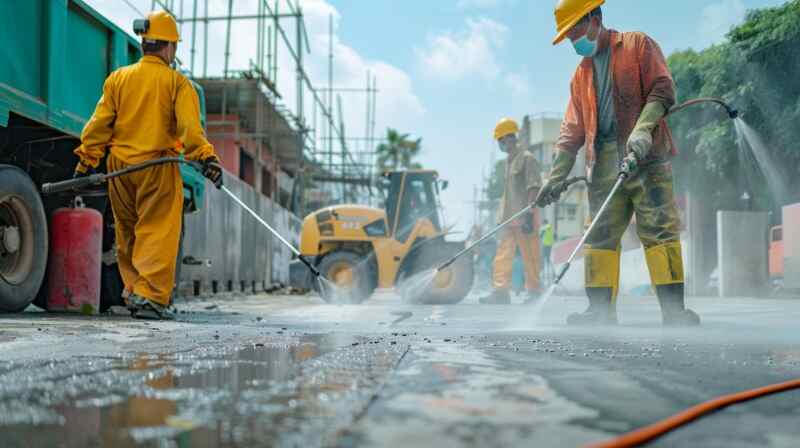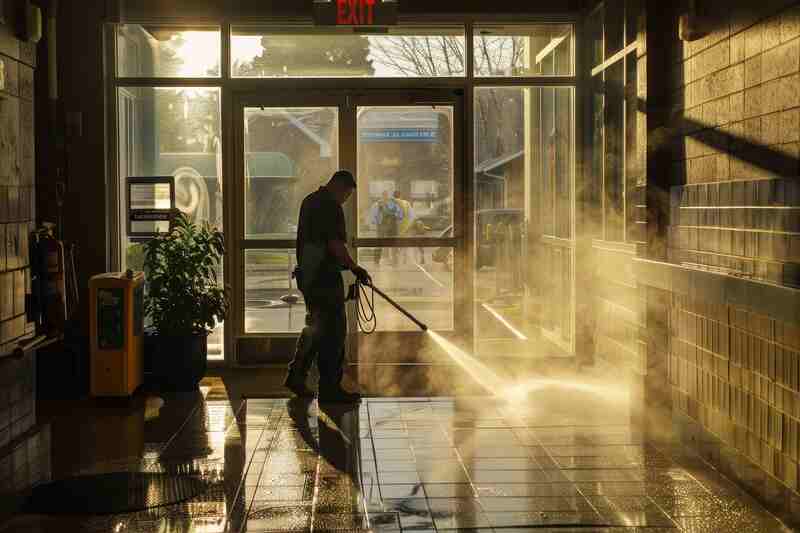How To Charge for Pressure Washing Jobs: A Guide
In the high-pressure world of cleaning services, setting the right price is like finding the perfect PSI: Too low, and you’re left in the red. Too high, and clients run for cover.
Pricing pressure washing services can be tricky. You need to cover your costs, make a profit, and still offer competitive rates. It’s a balancing act that requires careful thought and strategy.
This pressure washing pricing guide will walk you through different pricing methods, the steps in pricing a job, and tips for offering the best rates. Whether you’re just starting out or looking to fine-tune your offerings, we’ve got you covered.
RELATED ARTICLE — How To Start a Power Washing Business: Step-By-Step Guide
4 Common Pricing Strategies for Pressure Washing Jobs
There’s no one-size-fits-all approach to pricing your pressure washing services. Different power washing jobs call for different strategies. That’s why questions like “How much does it cost to pressure wash a house?” or “What’s the cost to pressure wash a driveway?” don’t always have a fixed answer. The cost depends on the pricing strategy you use.
Let’s explore four common pricing strategies used in the pressure washing business:
Flat Rate Pricing
This strategy involves charging a set price for specific services. For example, you might charge $200 for cleaning a standard-sized driveway, regardless of how long it takes.
Flat rate pricing works well for common, straightforward jobs where you can predict the time and resources needed. It’s easy for customers to understand and can help you book jobs quickly. However, you’ll want to be careful with unusual or larger projects that might take more time than expected.
Hourly Pricing
With this method, you charge a set amount for each hour you work. For instance, you might charge $35 per hour for your power washing services.
Setting your pressure washing prices per hour is great for jobs where you’re not sure how long the work will take, like cleaning heavily stained surfaces or working on oddly shaped areas. It ensures you’re paid for all the time you put in. The downside of hourly pricing is that some customers might worry about the final cost if the job takes longer than expected.
Per Square Foot Pricing
This strategy involves charging a specific amount for each square foot you clean. For example, you might charge $0.20 per square foot for driveway cleaning.
Setting your pressure washing prices per square foot works well for large, uniform surfaces like parking lots or warehouse floors. It’s fair and easy to explain to customers. However, it might not be the best choice for small jobs or areas with lots of obstacles that will slow down your work.
Project-Based Pricing
With this approach, you provide a custom quote based on the specific details of each job. You consider factors like the size of the area, type of surface, level of dirt, and any special challenges.
Project-based pricing is ideal for complex jobs or when you’re offering a mix of services. It allows you to account for all aspects of the job and make sure you’re fairly compensated. The drawback is that it can take more time to create accurate quotes for each project.
RELATED ARTICLE — How Much Does It Cost To Start a Business? A Comprehensive Guide
6 Steps to Price a Pressure Washing Job

These six steps will help you set fair and profitable rates for your pressure washing services. You’ll be able to quote jobs with confidence, knowing you’ve considered all the important factors. Let’s break it down:
1. Determine the Square Footage
The first step in pricing a pressure washing job is figuring out how big the area is. You’ll need to measure the length and width of the space you’re cleaning. Multiply these numbers together to get the square footage. For example, if a driveway is 20 feet long and 10 feet wide, the square footage is 200 (20 x 10 = 200).
Don’t forget about odd shapes and hard-to-reach spots. These might take extra time, so you might want to add a bit extra to your measurement. It’s better to estimate a little on the high side than to underestimate and lose money.
Consider Different Surfaces
When you’re measuring, pay attention to the types of surfaces you’ll be cleaning. Different materials need different cleaning methods and sometimes different equipment. For example, cleaning concrete might be quicker and easier than cleaning delicate siding.
Some surfaces might need special care or take more time to clean properly. This can affect your pricing. You might charge more for tougher jobs or surfaces that require extra attention.
FROM ONE OF OUR PARTNERS — The 7 Best Commercial Pressure Washers for Pros
2. Calculate Overhead and Materials Costs
To set the right price, you need to know how much it costs to run your business. These costs are called overhead. They’re the expenses you have even when you’re not cleaning. Here are some common overhead costs for a pressure washing business:
- Cleaning Equipment. This includes your power washers and other tools you use on the job, plus the cost of maintaining them.
- Safety Gear. These are things like gloves, goggles, and protective clothing.
- Business Protection. This is insurance to cover accidents or damage while working.
- Transportation Expenses. This covers your work vehicle and money for repairs.
- Advertising and Marketing. These are the costs for getting your name out there and finding new customers.
- Office Supplies. These include items like invoices, pens, and a computer.
- Business Software. These programs help you schedule jobs and keep track of payments.
Don’t forget about the supplies you use up on each job. These are called materials costs. For pressure washing, this might include cleaning solutions, water, and replaceable parts for your equipment.
Add up all these costs for a month. Then, depending on your pricing strategy, factor this total into your rates. For example, for hourly pricing, you’ll divide by your monthly billable hours. This gives you a baseline to ensure you’re covering your expenses, regardless of how you charge for your services.
RELATED ARTICLE — Overhead Costs: Examples, Definition, and Types
3. Estimate the Total Cost of the Job
Now it’s time to add everything up. The way you do this depends on your pricing strategy:
- For flat rate pricing, start with your set price for the job.
- For hourly pricing, estimate how long the job will take and multiply by your hourly rate.
- For per-square-foot pricing, multiply the area by your rate.
- For project-based pricing, consider all aspects of the job to come to a final price.
No matter which method you use, don’t forget to add in your overhead and materials costs. This total is the minimum you need to charge to break even on the job.
4. Add Your Profit Markup
To make money, you need to charge more than just your pressure washing costs. This extra amount is your profit. Making 30% on top of total costs is a common target for pressure washing companies.
For example, if your total cost for a job is $150, and you choose a 30% markup, you’d add $30. This brings your total price to $195. The markup you choose depends on your local market and how much experience you have. It’s okay to adjust your markup as your business grows and you learn what works best for you.
5. Consider Special Factors
Every power washing job is different, and some situations might affect your pricing. Here are three important things to think about:
- Extra Services. Customers might ask for additional work, like applying sealant or cleaning gutters. Charge more for these extras if you offer them.
- Travel Time. For jobs far away, consider adding a travel fee to cover gas and driving time.
- Job Difficulty. Trickier jobs, like cleaning multi-story buildings or heavily stained surfaces, may call for higher prices.
6. Create a Professional Pressure Washing Estimate
Now that you’ve figured out your pricing, it’s time to put it all together in a professional estimate. A good estimate helps customers understand what they’re paying for and shows that you’re organized. Include these key components:
- Your business name and contact information
- The customer’s name and address
- A clear description of the work you’ll do
- The total price, broken down by service
- How long you expect the job to take
- When you can start the job
- How the customer can pay you
Make sure your estimate looks neat and is easy to read. Double-check all your numbers before you send it. A well-made estimate can help you win the job and start the work on the right foot.
RELATED ARTICLE — How to Price Window Cleaning Jobs
3 Tips To Offer the Best Pressure Washing Prices

Setting the right price isn’t just about covering your power washing costs and making a profit. It’s also about staying competitive in your local market. Here are some smart ways to make your pressure washing prices attractive to customers while still running a successful business:
- Start With a Discount. If you’re new to pressure washing, offer a special deal to your first few customers. This can help you build experience and get good reviews. Just make sure you can still cover your costs.
- Create Service Packages. Bundle different services together at a slightly lower price than if customers bought them separately. For example, you could offer a “Spring Cleaning Package” that includes driveway, deck, and siding cleaning.
- Offer a Loyalty Program. Offer repeat customers a small discount. This can encourage people to use your services regularly, which means steady work.
FROM ONE OF OUR PARTNERS — What Is Customer Relations? Everything You Need To Know for Your Business
Win More Clients On-The-Spot With Quick and Professional Estimates
Now that you know what goes into creating a good estimate, automate the details with Joist.
Create and share estimates in just minutes with our easy-to-use mobile estimating tool, regardless of which pricing strategy you choose. Joist is packed with powerful features built for contractors including Deposits, Markups, Contracts and Photos. Try it today.